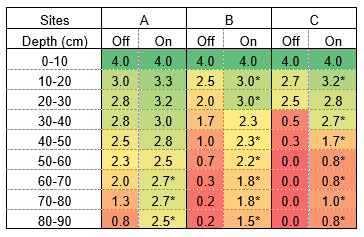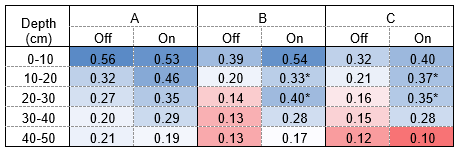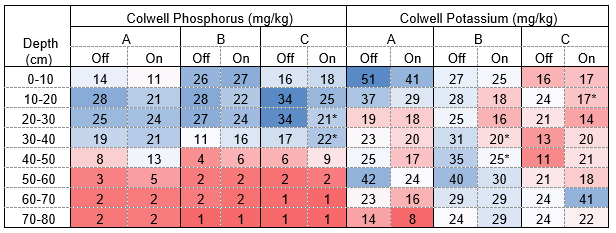To rip on or off the old rip line: a paddock-scale study on deep ripping and topsoil inclusion in a dry season
To rip on or off the old rip line: a paddock-scale study on deep ripping and topsoil inclusion in a dry season
Author: Bindi Isbister, Hasin Rahman, Gaus Azam, Joanne Walker, Melanie Kupsch and Ranny Wilkins | Date: 26 Feb 2024
Key messages
- Deep ripping sands with topsoil inclusion to 45cm increased canola yield on the rip line compared to off the rip line by 24–66% in a decile 1 rainfall season (123mm growing season rainfall achieving 100% of estimated yield potential).
- Four years after ripping, the topsoil inclusion had created a pathway of better soil pH and lower bulk density for more roots down the rip line through the compacted, acidic and aluminium-toxic subsoil — increasing organic carbon levels to 40cm depth and root access to deeper moisture and nutrients.
- Plant and soil measurements suggest that subsequent deep ripping with topsoil inclusion in the ‘off row’ to alleviate compaction, could improve pH and nutrition/organic matter. Creating an inclusion zone every 30cm would give each crop row close proximity to a rip line of better fertility and access to moisture each season further increasing yield and the longevity of the ripping benefit.
Aims
Measure the improvement in soil properties and subsequent gain in yield in a dry season, four years after deep ripping with topsoil inclusion plates, to ascertain the longevity of the ripping benefit in an acidic deep sand and determine whether and where to deep rip next.
Introduction
Deep ripping with topsoil inclusion plates has increased yield by 53% in sandy soils of Western Australia (Davies et al 2017). To achieve topsoil inclusion, a pair of steel ‘opener’ plates are bolted behind the deep ripping tines, the top of which runs about 10cm below the topsoil. This allows the topsoil to fall down the ripping slot between the plates, creating a channel of soil with higher organic matter and pH from the inclusion of surface-applied lime to the ripping depth, i.e. typically 45–60cm. This provides a pathway for crop roots through the subsoil, which is often constrained by subsoil acidity, compaction and low fertility, improving access to moisture and nutrients in the deeper subsoil (Parker and Isbister 2017). The deeper subsoils (below 45–60cm depth) are often benign but remain unexplored by the crop roots due to very few macropores or old root channels with which roots can grow through the acidic-compacted layer above. It is hypothesised that the addition of topsoil with higher organic matter and more root residues from better root growth could also increase the longevity of the deep ripping treatment stabilising the loosened soil and reducing the frequency of ripping intervals. Research undertaken in the DPIRD and GRDC co-invested project DAW1902-003RTX “Re-engineering soils to improve the access of crop root systems” to benchmark the effect of soil amelioration on crop yield using grower data over 10 years pre- and post-amelioration found that deep ripping can increase yield post amelioration, however the yield response can vary with different soil types in a paddock (Clausen et al 2021). This soil type effect is evident at the grower case study located 75km east of Geraldton, WA. In this study, we monitored two paddocks treated the same agronomically but which have been limed and ripped with topsoil inclusion in different seasons until 2020 when both paddocks were deep ripped with topsoil inclusion to 45cm.
Paddock monitoring of the case study paddocks on 19 July 2023 observed better canola crop growth on the rip lines compared to off the rip lines. Excavation with a spade showed that there was more moisture in the rip lines than off the rip lines after a 3mm rainfall event that morning. Before this only 76mm rain had been received for April to July with only one 11mm event in June exceeding 8mm for the season to date. This raised the question from the grower, who is planning to re-rip these paddocks in 2024 (a four-year ripping cycle), whether they should rip on or off the previous rip line? Paddock observations have found the rip lines with topsoil inclusion are not re-compacting in the better high yielding sands in the paddock, but a narrow compaction layer still remains 45–55cm deep at the bottom of the rip line. To investigate this question and to quantify the benefits of topsoil inclusion in a decile one year (123mm growing season rainfall) soil pits were dug in the three different soil types, covering ripped and unripped soil profiles, in the paddock on 20 August at peak flowering for the canola and crop yield was measured on and off the rip line at the same locations.
Method
This trial was a large-scale grower case study of deep ripping with topsoil inclusion plates on the Eradu sandplain, 75km east of Geraldton. The paddocks were deep ripped to 45cm with topsoil inclusion on 60cm row spacing in 2016–2017 and 2020.
In August 2023, soil pits were dug across the rip lines in the three soil type zones consisting of variations of a Yellow Arenosol (acidic deep sand): (i) pit A fine sand (high yielding), (ii) pit B medium sand (medium yielding) and (iii) pit C coarse sand (low yielding). Measurements were taken over a 10 x 10cm grid, including root abundance on pit face (1200 x 900mm) soil testing at 10cm increments on and off the rip lines for bulk density, moisture, pH, extractable aluminium concentration and soil nutrition status on <2 mm sieved soil fraction. The root abundance was scored from 0 (no roots) to 4 (abundant, >200 roots per grid cell) (McDonald and Isbell 2009).
Harvest cuts were taken on and off the rip lines to measure biomass and grain yield tonnes/hectare. Protein and oil content were measured using an InfratechTM 1241 Grain Analyzer. A statistical t-test was used to compare results on and off the rip line. The water use efficiency (WUE) was calculated using the equation WUE = Yield kg/ha / (0.25 x summer rain + growing season rainfall) – 50mm evaporation) (Harries et al 2022). In 2023 the summer rainfall November to March was 67mm and the growing season rainfall April to October was 123mm.
The paddock rotation since 2016 has been wheat/canola/wheat/lupin/wheat/canola/wheat/canola. In 2023 the canola was sown dry 29 April to 2 May at 1.8kg/ha variety Emu pits A and B (paddock A9), 2–4 May at 1.8kg/ha variety 44Y27RR pit C (paddock A10). Average fertiliser rate applied was; at seeding 89 kg/ha MAPZC 70% MOP 30% MaxamFlo 68.7 L/ha; post-seeding on 15 June 179.4kg/ha urea 45% MaxAm 40% MOP 15%; and at branching on 2 August UAN 30L/ha.
The farm has been fully matched with a controlled traffic farming system since 2016. The ripping spacing is 60cm, and the seeding row spacing is 31cm. Each year the seeding bar is shifted across using a Protrakker system so the crop rows run between the previous stubble. In 2022, the wheat rows were either side of the rip line and in 2023, the canola rows alternated between either directly on the rip line or off (between) the rip lines. In previous seasons a difference in plant growth on and off the rip lines has not been observed.
Results
Canola yield was higher on the rip line than off the rip line at all three sites. There was an average yield increase of 0.53t/ha at site A (fine sand), 0.26t/ha at site B (medium sand) and 0.34t/ha at site C (coarse sand) (Table 1).
Table 1. Canola yield (t/ha) and water use efficiency (kg/ha/mm) 2023 at three soil types in one paddock site A Fine Sand, B Medium Sand and C Coarse Sand
*Significant difference 5% Note: Grain value @$650 per tonne over 44% of the paddock (12% wheeled not ripped and then yield response applied over half the remaining area).
There was no significant differences in protein, oil content or 1000-grain weights on or off the rip line. Average grain quality measurements for canola across the soil types and varieties were site A and B (Emu): oil 47.1%, protein 18.5% 1000-grain weight 3.6g; site C (44Y27RR): oil 44%, protein 21.5%, 1000-grain weight 4.2g.
There was no significant difference in root abundance at the 0–10cm depth for all sites, on or off the rip line. There was a significant increase in canola root number from 10cm on the rip line compared to off the rip line: at site B, medium sand, and site C, coarse sand (Table 2). Site C had the largest differences in root abundance from 30cm to the deepest depth of assessment; below 50cm, no roots were found off the rip line, while some roots were found on the rip line. For site A, the loamy sand, there was no significant increase in root abundance except in the 60–90cm soil layer with more roots on the rip line.
Table 2. Average root abundance score on and off the rip line in 10cm increments to 90cm for three soil type sites A (Fine Sand), (B Medium Sand) and C (Coarse Sand) on 20 August 2023, 113 days after sowing. 0 = 0 roots, 1 = few 2 = common 3= many 4 = abundant (McDonald and Isbell 2009). Colours indicate pattern not critical values
*p <0.05 Significant difference off vs on rip line for each soil type/pit.
Soil pH was significantly higher on the rip line for 20–50cm depth for all soil types compared to off the rip line (Table 3). For site C, soil pH off the rip line was below subsoil target pH (CaCl2) of 4.8 below 10cm and was very acidic 20–50cm 4.2–4.3 (Table 3). This resulted in high aluminium levels at this depth of 6–9.1mg/kg that are highly toxic to root growth. The soil pH at all three sites increased below 50cm.
Table 3. Soil pH and extractable aluminium (CaCl2) off and on the rip lines at 10cm increments to 80cm for three soil sites A (Fine Sand), B (Medium Sand) and C (Coarse Sand) on 20 August 2023. Colours indicate patterns not critical values
*p <0.05 Significant difference off vs on for each soil type
Bulk density was lower in the rip line compared to off the rip line at 20–50cm depth at all sites. At sites A and C, the bulk density was similar at 10–20cm depth on and off the rip line; site A 1.3g/cm3 and C 1.5g/cm3 (Table 4). Of the three soil types, site A (fine sand) had the lowest bulk density and site C (coarse sand) had the highest. There was significantly less water on the rip line for sites A and B at 10–20cm compared to off the rip line. There was significantly less water on the rip line at the 10–50cm depth at pit C compared to off the rip line. Site C had higher water content below 50cm than the other two sites.
Table 4. Bulk density and Volumetric Water content off and on the rip lines at 10cm increments to 80cm for three soil types A (Fine Sand), B (Medium Sand) and C (Coarse Sand) on 20 August 2023. Colours indicate differences not critical values
*p <0.05 Significant difference off vs on for each soil type
There was more organic carbon at 10–30 cm on the rip line at sites B and C (Table 5) and a difference at 10% level at 30–40cm at site A. There was no difference in organic carbon content below 50cm (data not shown).
Table 5. Organic carbon (%) off and on the rip lines at 10cm increments to 80cm at three soil type sites, A (Fine Sand), B (Medium Sand) and C (Coarse Sand) on 20 August 2023. Colours indicate patterns not critical values
*p <0.05 Significant difference off vs on for each soil type
Levels of ammonium nitrate and nitrate were negligible at all sites and depths <1mg/kg (data not shown).
There was a trend of lower phosphorus (P) on the rip line to 30cm, however it was highly variable and the difference was only significant at 10–20cm depth at site A and 20–30cm depth at site C. There was a trend of higher P at 30–40cm and 40–50cm on the rip line, but the difference was only significant at site C 30–40cm (Table 6). The trend for potassium (K) was for lower levels on the rip line to a depth of 60cm or more, depending on the site, however the difference was only significant for site B at 20–50cm and site C at 10–20cm. K levels are deficient at all sites particularly at C which is the lowest yielding soil type in these paddocks.
Table 6. Phosphorus and Potassium off and on the rip lines at 10cm increments to 80cm at three soil type sites A (Fine Sand), B (Medium Sand) and C (Coarse Sand) on 20 August 2023. Colours indicate patterns not critical values
*p <0.05 Significant difference off vs on for each soil type Note: <15 mg/kg is the lowest K level reported by the lab, values below this have been considered 7.5mg/kg for statistical purposes.
Conclusion
Deep ripping with topsoil inclusion to 45cm depth has increased crop yield on the rip line compared to off the rip line by 24–66% in a decile 1 rainfall season, four seasons after the ripping was undertaken. Topsoil inclusion down the rip line has created a pathway of better soil pH for roots through the compact, acidic subsoil particularly in the deep yellow medium sand and coarse sand where low pH is associated with aluminium toxicity. There was a greater root abundance down the ripping slot. This effect has been observed in previous research on topsoil inclusion with more roots deeper in the profile below 30cm depth compared to the nil treatment (Parker 2020). The lower moisture levels in the rip line indicate the crop roots have extracted more moisture from deeper in the profile than the plants off the rip line. What has not been measured is the possible effect of water harvesting into the rip lines early in the season, with higher organic matter helping store this moisture in the rip line. This moisture could increase nutrient availability during early growth, setting up a higher yield potential. The difference in growth on and off the row was visible from early in the season. Damon et al (2022) found wheat growth differences early in the season where wheat plants were grown directly on top of a lime-amended slot and accessed rubidium tracer 21 days after sowing compared to plants 4, 9 or 11cm away from the slot which accessed the tracer at 35, 42 or 49 days from sowing. There was no significant difference in grain quality including protein, oil content or 1000-grain weight suggesting the crop on or off the row was able to fill grain at its set yield potential.
Nutrition results are variable but do suggest the plants have accessed more K on the rip line on the medium yellow sand. These soil profile measurements indicate there is no K ‘reserve’; sitting deeper in the profile at 50-80 cm so applying K fertiliser will be important to maintain supply to the crop and yield potential.
Bulk density measurements indicate that the bulk density 20–50cm remains lower on the rip line than off four years after deep ripping with topsoil inclusion. Higher organic carbon and root matter in the rip line could help sustain and stabilise the soil loosened by ripping. The bulk density was lowest in the loamy sandy soil, which could explain why there are similar root numbers to 50cm.
The yield and soil measurements suggest the next time deep ripping with topsoil inclusion is undertaken it should be done on the ‘off row’, between the previous rip lines, to alleviate compaction and improve soil pH, nutrition and organic matter in that zone. This would likely increase yield, reduce resettling and natural re-compaction of the subsoil. Topsoil inclusion slots every 30cm would give each crop row close proximity to a zone of better fertility and access to moisture every season.
Acknowledgments
We acknowledge the support from Mr Brad Smith, Geraldton for hosting the case study paddock for the past five years. The research undertaken as part of this project is made possible by the significant contributions of growers through both trial cooperation and the support of the GRDC, the authors thank them for their continued support. GRDC and DPIRD co-investment project DAW1902-003RTX Re-engineering soils to improve the access of crop root systems to water and nutrients stored in the subsoil.
References
Clausen J, Isbister B, Bruce J, Davies S and Murfit T (2021) Benchmarking soil amelioration outcomes using paddock yield and water use efficiency data, GRDC Research Updates 2021, 22-23 February, Perth, Western Australia.
Davies S, Parker W, Blackwell P, Isbister B, Betti G, Gazey G and Scanlan C (2017) Soil amelioration in Western Australia - what techniques are providing benefits? GRDC Grains Research Updates, 7-8 February 2017, Adelaide, South Australia.
Damon PM, Azam G, Gazey C, Scanlan C, Rengel Z (2022) Response of wheat to the geometry and proximity of lime slotting in an acid profile, Soil & tillage Research, 217.
Harries M, Flower K, Renton M, Anderson G (2022) Water use efficiency in Western Australian cropping systems, Crop & Pasture Science, https://doi.org/10.1071/CP21745Parker W and Isbister B (2017) Subsoil compaction management: outcomes of five years of research in Western Australia - GRDC, GRDC Updates Perth.
McDonald RC and Isbell RF (2009) Roots. In ‘Australian soil and land survey field handbook (3rd edition).’ National Committee on Soil and Terrain. CSIRO Publishing: Melbourne.
Contact details
Bindi Isbister
Department of Primary Industry and Regional Development WA
20 Gregory Street, Geraldton, WA. 6530
Ph: (08)99568532
Mobile: 0436682497
Email: Bindi.Isbister@dpird.wa.gov.au
Peer reviewed by: Dr Stephen Davies, DPIRD
GRDC Project Code: DAW1902-003RTX,






